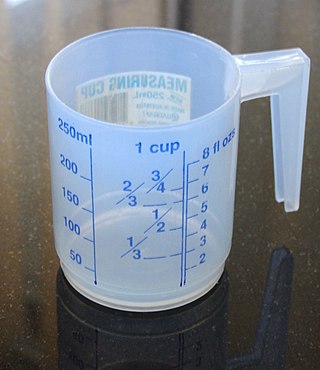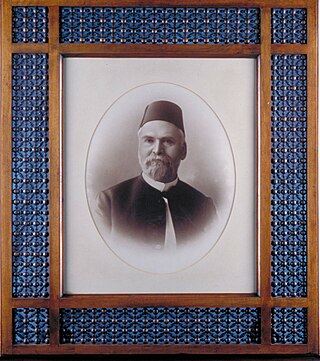
The Great Pyramid of Giza is the largest Egyptian pyramid and served as the tomb of pharaoh Khufu, who ruled during the Fourth Dynasty of the Old Kingdom. Built c. 2600 BC, over a period of about 27 years, the pyramid is the oldest of the Seven Wonders of the Ancient World, and the only wonder that has remained largely intact. It is the most famous monument of the Giza pyramid complex, which is part of the UNESCO World Heritage Site "Memphis and its Necropolis". It is situated at the northeastern end of the line of the three main pyramids at Giza.

Volume is a measure of regions in three-dimensional space. It is often quantified numerically using SI derived units or by various imperial or US customary units. The definition of length and height (cubed) is interrelated with volume. The volume of a container is generally understood to be the capacity of the container; i.e., the amount of fluid that the container could hold, rather than the amount of space the container itself displaces. By metonymy, the term "volume" sometimes is used to refer to the corresponding region.

Charles Piazzi Smyth was a British astronomer who was Astronomer Royal for Scotland from 1846 to 1888; he is known for many innovations in astronomy and, along with his wife Jessica Duncan Piazzi Smyth, his pyramidological and metrological studies of the Great Pyramid of Giza.

The cubit is an ancient unit of length based on the distance from the elbow to the tip of the middle finger. It was primarily associated with the Sumerians, Egyptians, and Israelites. The term cubit is found in the Bible regarding Noah's Ark, the Ark of the Covenant, the Tabernacle, and Solomon's Temple. The common cubit was divided into 6 palms × 4 fingers = 24 digits. Royal cubits added a palm for 7 palms × 4 fingers = 28 digits. These lengths typically ranged from 44.4 to 52.92 cm, with an ancient Roman cubit being as long as 120 cm.

Sir William Matthew Flinders Petrie, commonly known as simply Sir Flinders Petrie, was a British Egyptologist and a pioneer of systematic methodology in archaeology and the preservation of artefacts. He held the first chair of Egyptology in the United Kingdom, and excavated many of the most important archaeological sites in Egypt in conjunction with his wife, Hilda Urlin. Some consider his most famous discovery to be that of the Merneptah Stele, an opinion with which Petrie himself concurred. Undoubtedly at least as important is his 1905 discovery and correct identification of the character of the Proto-Sinaitic script, the ancestor of almost all alphabetic scripts.

The hand is a non-SI unit of measurement of length standardized to 4 in (101.6 mm). It is used to measure the height of horses in many English-speaking countries, including Australia, Canada, Ireland, the United Kingdom, and the United States. It was originally based on the breadth of a human hand. The adoption of the international inch in 1959 allowed for a standardized imperial form and a metric conversion. It may be abbreviated to "h" or "hh". Although measurements between whole hands are usually expressed in what appears to be decimal format, the subdivision of the hand is not decimal but is in base 4, so subdivisions after the radix point are in quarters of a hand, which are inches. Thus, 62 inches is fifteen and a half hands, or 15.2 hh.
The megalithic yard is a hypothetical ancient unit of length equal to about 2.72 feet (0.83 m). Some researchers believe it was used in the construction of megalithic structures. The proposal was made by Alexander Thom as a result of his surveys of 600 megalithic sites in England, Scotland, Wales and Brittany. Thom also proposed the megalithic rod of 2.5 megalithic yards, or on average across sites 6.77625 feet. As subunits of these, he further proposed the megalithic inch of 2.073 centimetres (0.816 in), one hundred of which are included in a megalithic rod, and forty of which composed a megalithic yard. Thom applied the statistical lumped variance test of J.R. Broadbent on this quantum and found the results significant, while others have challenged his statistical analysis and suggested that Thom's evidence can be explained in other ways, for instance that the supposed megalithic yard is in fact the average length of a pace.

The palm is an obsolete anthropic unit of length, originally based on the width of the human palm and then variously standardized. The same name is also used for a second, rather larger unit based on the length of the human hand.

Pyramidology refers to various religious or pseudoscientific speculations regarding pyramids, most often the Giza pyramid complex and the Great Pyramid of Giza in Egypt. Some "pyramidologists" also concern themselves with the monumental structures of pre-Columbian America, and the temples of Southeast Asia.

Meidum, Maydum or Maidum is an archaeological site in Lower Egypt. It contains a large pyramid and several mudbrick mastabas. The pyramid was Egypt's first straight-sided one, but it partially collapsed in ancient times. The area is located around 72 kilometres (45 mi) south of modern Cairo.

The earliest recorded systems of weights and measures originate in the 3rd or 4th millennium BC. Even the very earliest civilizations needed measurement for purposes of agriculture, construction and trade. Early standard units might only have applied to a single community or small region, with every area developing its own standards for lengths, areas, volumes and masses. Often such systems were closely tied to one field of use, so that volume measures used, for example, for dry grains were unrelated to those for liquids, with neither bearing any particular relationship to units of length used for measuring cloth or land. With development of manufacturing technologies, and the growing importance of trade between communities and ultimately across the Earth, standardized weights and measures became critical. Starting in the 18th century, modernized, simplified and uniform systems of weights and measures were developed, with the fundamental units defined by ever more precise methods in the science of metrology. The discovery and application of electricity was one factor motivating the development of standardized internationally applicable units.
John Taylor was an English publisher, essayist, and writer. He is noted as the publisher of the poets John Keats and John Clare.

A measuring rod is a tool used to physically measure lengths and survey areas of various sizes. Most measuring rods are round or square sectioned; however, they can also be flat boards. Some have markings at regular intervals. It is likely that the measuring rod was used before the line, chain or steel tapes used in modern measurement.
Some approaches in the branch of historic metrology are highly speculative and can be qualified as pseudoscience.

Seked is an ancient Egyptian term describing the inclination of the triangular faces of a right pyramid. The system was based on the Egyptians' length measure known as the royal cubit. It was subdivided into seven palms, each of which was sub-divided into four digits.
The geographical centre of Earth is the geometric centre of all land surfaces on Earth. Geometrically defined it is the centroid of all land surfaces within the two dimensions of the Geoid surface which approximates the Earth's outer shape. The term centre of minimum distance specifies the concept more precisely as the domain is the sphere surface without boundary and not the three-dimensional body.
Jessica Duncan Piazzi Smyth made geological tours of the British Isles and Europe, and traveled to Egypt, Tenerife, and throughout the Mediterranean on scientific expeditions with her husband, Charles Piazzi Smyth, the Astronomer Royal for Scotland.
A number of different units of measurement were used in Sri Lanka to measure quantities like length, mass and capacity from very ancient times. Under the British Empire, imperial units became the official units of measurement and remained so until Sri Lanka adopted the metric system in the 1970s.

James Andrew Sandilands Grant (Bey) (1840–1896) was a Scottish physician and antiquarian. He was educated as a doctor of medicine at the University of Aberdeen in Scotland and then spent several years working in Egypt combatting outbreaks of cholera and working as a general practitioner. While he was there, he became well informed about the antiquities and culture of ancient Egypt and he went on to develop expertise in that field. He bequeathed a collection of his antiquities to the museum of the University of Aberdeen.











